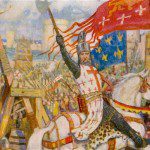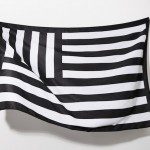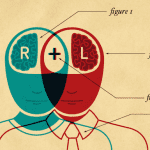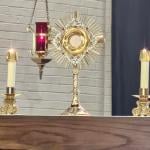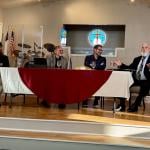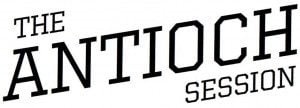 Perhaps the most difficult thing about identifying as a Christian is getting along with other self-identifying Christians. We even fight over the definition of the word: “if you don’t believe/do _______, then you aren’t a real Christian.” The disagreements that divide us are more complex than simply progressive vs. conservative. Diving deeper, one can see multiple divisions between those who are closely aligned theologically and politically. As a progressive Christian, I’ve seen these divisions first-hand.
Perhaps the most difficult thing about identifying as a Christian is getting along with other self-identifying Christians. We even fight over the definition of the word: “if you don’t believe/do _______, then you aren’t a real Christian.” The disagreements that divide us are more complex than simply progressive vs. conservative. Diving deeper, one can see multiple divisions between those who are closely aligned theologically and politically. As a progressive Christian, I’ve seen these divisions first-hand.
Don’t get me wrong. Disagreement is healthy and sharpens each of us. However, too many times disagreements become relationship-killers. After a harsh exchange, we excommunicate yet another individual or another group of people from our spheres of friendship and influence. I’ve done plenty of excommunicating myself; in fact, I continue to practice it. I must stop doing this, but how?
I’d like to share a concept that helps me resist the urge to excommunicate. It helps me understand the value of diversity within the Body of Christ, even when this diversity unsettles and dislodges us. I call this concept the Tolerance Range. Think of your Tolerance Range as the “area” surrounding your own worldview where you feel most comfortable engaging.
*****
We each have a worldview that falls somewhere on the progressive/conservative continuum. I fall on the progressive side of the continuum, and I’ve estimated my own worldview and Tolerance Range in the example below:
Tolerance Ranges are not necessarily equidistant to the left and right. One may have a lot of tolerance for ideas to the left and little tolerance for ideas to the right. (See example above!)
While the linear model is useful, it does not fully capture the three dimensional quality of individuals–their identities, beliefs, personalities, and experiences. Additionally, the terms progressive and conservative don’t do justice to the complexity of our outlooks. We define progressive and conservative views in politics and Christian theology, but we also define views on topics such as parenting, economics, sexuality, education, health and wellness, science, etc. It may help to picture a sphere instead of a line, and to picture your Tolerance Range as a 3-dimensional portion of that sphere (example shown below).
The size and scope of Tolerance Ranges vary based on past history, education, experience, privilege, and marginalization. Additionally, abuse of any kind can severely alter and limit this range. The damage done by abuse complicates one’s ability to trust and connect with others (yet another reason why abuse is so evil).
The question remains: how does this concept help us understand the value of diversity within the Body of Christ? To demonstrate, I will use examples within the progressive Christian realm.
*****
In my experience in progressive Christianity, I’ve noticed two distinct roles: the activist and the bridge-builder. Using the language of spiritual gifts, activists are prophets and bridge-builders are teachers. Too often, prophets and teachers despise and excommunicate people from the other group. Why? It might help to look at the characteristics and priorities of each group.
Prophets advocate for the poor, the marginalized, and the outcasts. They are uncompromising in their pursuit of justice, and they work to move the conversation forward in the public sphere. They are “ahead of their time.” Teachers seek common ground. They work to influence individuals through trust and relationship. However, the human connection itself (more than the influence sought) becomes the primary priority of the teacher—human connection reveals the Divine.
In relation to the Tolerance Range model, prophets work primarily outside of their listeners’ tolerance range, and teachers work primarily inside of their listeners’ tolerance range. The priorities and methods of each group fall outside of the other group’s tolerance range, which is a major source of conflict, misunderstanding, and dissension. Looking at their characteristics and priorities, both roles clearly have value. Both roles are needed in the Body of Christ.
It should be noted that no one person is pure prophet or pure teacher. Human beings are too complex for such unilateral roles. Prophets foster personal relationships, especially with the powerless and the virtually-invisible in society. Teachers participate in the public sphere, and speak truth boldly to power when the situation calls for it.
Human beings are tribal. Finding like-minded friends and allies is a part of our humanity; it is a survival instinct. Jesus asks us to go beyond our tribes and love those outside of our tribes–to love those whose ideas and behaviors are outside of our tolerance ranges.
Not all of us have the ability or the opportunity to reach and connect with everybody. Thankfully, we have a wide diversity of worldview, methods, and priorities within the Body of Christ. As we grow in the Spirit, we can expand our capacity for love; in the meantime, the diversity of the Body of Christ can meet diverse needs. So let’s not disparage those who are not like us. A prophet calling out injustice and a teacher patiently influencing open hearts are both acts of love. We can therefore trust the Spirit is working through them.
My hope is that the Tolerance Range model sparks conversation around issues of Christian unity and diversity. I’ve provided an example of differing roles and tolerance ranges from a progressive Christian viewpoint. I’m wondering if those on the more Conservative side find anything useful in this model?
What other thoughts or insights do you have after reading this post?
—







